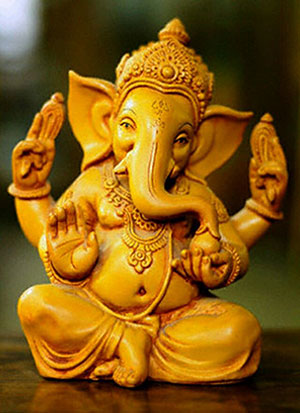Who is Lord Ganesh? What does ‘Ganesha’ mean?
Lord Ganesha is one of the celestial deities holding the divine prominence in Vedic scriptures. His form, intellect, divinity and strengths are glorified in the Ganesh Purana. He is Ganesha or Ganapati who is the Lord of masses that worship him for His blessings. He is the first Vedic Deity worshipped first at the altar before other Deities at a ritual or a venture. He is the ruling deity of the Muladhara Chakra and blesses his devotees with wisdom and ability to face challenges and obstacles in life. He has a pot belly signifying contentment and fullness. He holds a fragrant Modak in His left hand signifying the bliss of satisfaction that he provides. His vehicle, the Mouse, signifies that one needs to curb vices (signified by mice) to achieve his state.

The Sanskrit word Ganesha is made of gana meaning a group or a cluster and isha meaning the controller, the leader or the master. The gana in an actual sense means a group of saintly beings serving as a retinue of Mahadeva (Shiva). Lord Ganesha is also known as Ganapati; gana meaning a group (of beings) and pati means the ruler who protects.
Sanskrit lexicon Amarakosha mentions others names of Ganesha as well: Vignaharta-One who removes obstacles; Gaṇādhipa-One who leads masses, Ekadanta-One who has one tusk; Heramba, Lambodara-one who has a pot belly and Gajanana-one who has the face of an elephant.
Various names of Lord Ganesha:
Lord Ganesha is prayed and worshipped by many names describing His stature. Few of the most famous names by which Lord Ganesha is worshipped:
- Ganpati – The Lord of all lords
- Sumukh – The Lord with a beautiful face
- Vinayaka – The prominent Lord of all
- Gajanana – The Elephant headed God
- Ek Danta – The Lord with one tusk
- Lambkarna – Long Eared God
- Vigneshwara – Remover of all the obstacles
Puranas mention that Lord Ganesha is the God of letters, learning and wisdom. In Sanskrit, the word Buddhi is a feminine noun that is variously translated as intelligence, wisdom, or intellect. The Ganesh Purana and Ganesh Sahasranama (thousand names of Ganesha) mention one of His names as Buddhipriya, the one who is fond of intelligence.
A manuscript discovered in the Indian state of Rajasthan in the 17th century mentions Saint Vyasa narrating the great epic Mahabharata to Lord Ganesh, who acts as a scribe. The Rig Veda mentions ‘Leader of the group’ (ganeshorganapati) at two places. It appears in the verse 2:23:1 as a title to Brahmanaspati which was subsequently taken as the mode of worship for Ganesha. Another place is the verse 10:112:9 where Ganapati is referred as Indra who rules the celestial beings. Many commentators on the Vedas opine that both the verses may not actually be in reference to Ganesha but any celestial being that rules and protects the divine beings from asuras. However, the Ganapatya scriptures mention the Rig Vedic verses to honor Lord Ganesha.The Yajur Veda, MaitrayaniyaSamhita (2:9:1) and TaittiriyaAranyaka (10:1) mention a deity as dantith (the tusked one), hastimukhai (elephant-faced) and vakratunda (one with a curved trunk). As per Shiva Purana, Ganesha had sired two children: Kşema (success) and Lābha (profit). In northern Indian variations of this story, the children are said to be Śubha (auspiciouness) and Lābha.
One of the major sources of information on Ganesha is Ganesha Purna which splits into two sections; the Upasanakhanda (upāsanākhaṇḍa) and the Kridakhanda (krīḍākhaṇḍa). The Kridakhanda is also known as the Uttarakhanda (uttarakhaṇḍa). Upasanakhanda includes a stotra (hymn) that is dedicated to Lord Ganesha and recited in Hindu temples as a living part of Ganesha devotion. The Kridakhanda of the Ganesha Purana features the stories about the four divine incarnations that appear in the four different yugas.





.jpg)


Comments 0
Leave your thought here